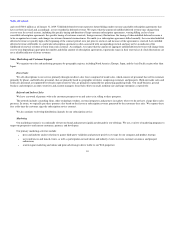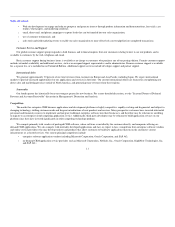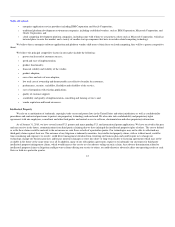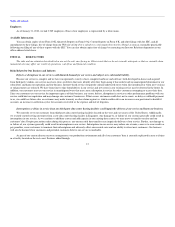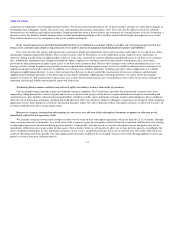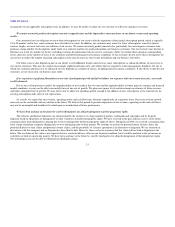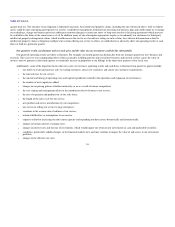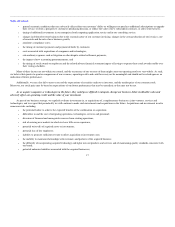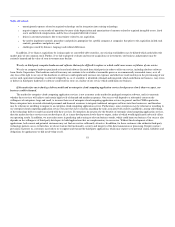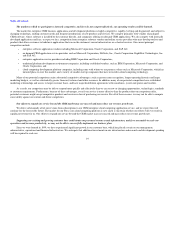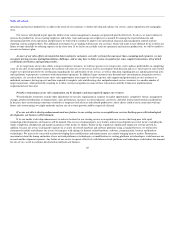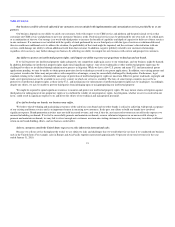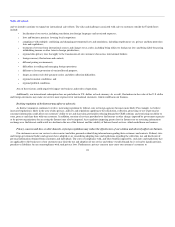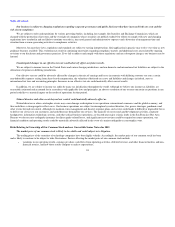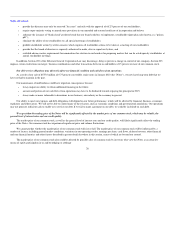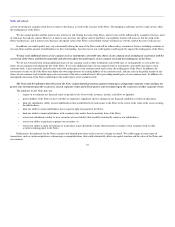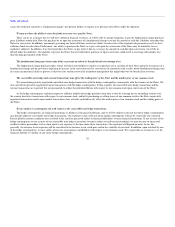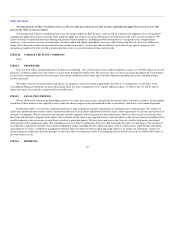Salesforce.com 2009 Annual Report Download - page 22
Download and view the complete annual report
Please find page 22 of the 2009 Salesforce.com annual report below. You can navigate through the pages in the report by either clicking on the pages listed below, or by using the keyword search tool below to find specific information within the annual report.
Table of Contents
The market in which we participate is intensely competitive, and if we do not compete effectively, our operating results could be harmed.
The market for enterprise CRM business applications and development platforms is highly competitive, rapidly evolving and fragmented, and subject to
changing technology, shifting customer needs and frequent introductions of new products and services. We compete primarily with vendors of packaged
CRM software, whose software is installed by the customer directly, and companies offering on-demand CRM applications. We also compete with internally
developed applications and face, or expect to face, competition from enterprise software vendors and online service providers who may develop toolsets and
products that allow customers to build new applications that run on the customers' current infrastructure or as hosted services. Our current principal
competitors include:
• enterprise software application vendors including Microsoft Corporation, Oracle Corporation, and SAP AG;
• on-demand CRM application service providers such as Microsoft Corporation, NetSuite, Inc., Oracle Corporation, RightNow Technologies, Inc.
and SAP AG;
• enterprise application service providers including IBM Corporation and Oracle Corporation;
• traditional platform development environment companies, including established vendors, such as IBM Corporation, Microsoft Corporation, and
Oracle Corporation; and
• cloud computing development platform companies, including some with whom we are partners, others such as Microsoft Corporation, which has
initiated plans to enter this market, and a variety of smaller start up companies that have invested in cloud computing technology.
Many of our potential competitors enjoy substantial competitive advantages, such as greater name recognition, longer operating histories and larger
marketing budgets, as well as substantially greater financial, technical and other resources. In addition, many of our potential competitors have established
marketing relationships and access to larger customer bases, and have major distribution agreements with consultants, system integrators and resellers.
As a result, our competitors may be able to respond more quickly and effectively than we can to new or changing opportunities, technologies, standards
or customer requirements. Furthermore, because of these advantages, even if our service is more effective than the products that our competitors offer,
potential customers might accept competitive products and services in lieu of purchasing our service. For all of these reasons, we may not be able to compete
successfully against our current and future competitors.
Our efforts to expand our service beyond the CRM market may not succeed and may reduce our revenue growth rate.
We derive substantially all of our revenue from subscriptions to our CRM enterprise cloud computing application service, and we expect this will
continue for the foreseeable future. The market for our Force.com cloud computing platform is new and it is uncertain whether our efforts will ever result in
significant revenue for us. Our efforts to expand our service beyond the CRM market may not succeed and may reduce our revenue growth rate.
Supporting our existing and growing customer base could strain our personnel resources and infrastructure, and if we are unable to scale our
operations and increase productivity, we may not be able to successfully implement our business plan.
Since we were formed in 1999, we have experienced significant growth in our customer base, which has placed a strain on our management,
administrative, operational and financial infrastructure. We anticipate that additional investments in our infrastructure and research and development spending
will be required to scale our
19



